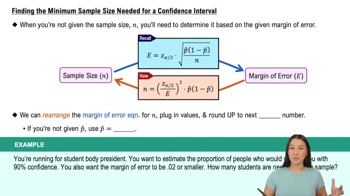Table of contents
- 1. Intro to Stats and Collecting Data55m
- 2. Describing Data with Tables and Graphs1h 55m
- 3. Describing Data Numerically1h 45m
- 4. Probability2h 16m
- 5. Binomial Distribution & Discrete Random Variables2h 33m
- 6. Normal Distribution and Continuous Random Variables1h 38m
- 7. Sampling Distributions & Confidence Intervals: Mean1h 3m
- 8. Sampling Distributions & Confidence Intervals: Proportion1h 12m
- 9. Hypothesis Testing for One Sample1h 1m
- 10. Hypothesis Testing for Two Samples2h 8m
- 11. Correlation48m
- 12. Regression1h 4m
- 13. Chi-Square Tests & Goodness of Fit1h 20m
- 14. ANOVA1h 0m
8. Sampling Distributions & Confidence Intervals: Proportion
Confidence Intervals for Population Proportion
Struggling with Statistics?
Join thousands of students who trust us to help them ace their exams!Watch the first videoMultiple Choice
You want to make a confidence interval for the population proportion of people between years old who have gotten a speeding ticket in the past years. A prior study found that of people between years old have received a speeding ticket in the last year. If you want your estimate to be accurate within of the true population proportion, what is the minimum sample size needed?
A
1007
B
1006
C
579
D
1309
 Verified step by step guidance
Verified step by step guidance1
Identify the key components needed for calculating the sample size for a confidence interval for a population proportion. These include the desired confidence level, the margin of error, and an estimate of the population proportion.
For a 97% confidence interval, determine the z-score associated with this confidence level. The z-score is a critical value that corresponds to the desired level of confidence. For a 97% confidence level, the z-score is approximately 2.17.
Use the formula for the sample size of a population proportion: n = (z^2 * p * (1-p)) / E^2, where n is the sample size, z is the z-score, p is the estimated population proportion, and E is the margin of error.
Substitute the known values into the formula: z = 2.17, p = 0.26 (from the prior study), and E = 0.03 (the desired margin of error).
Calculate the sample size using the formula. Ensure that the result is rounded up to the nearest whole number, as the sample size must be a whole number.

 5:45m
5:45mWatch next
Master Constructing Confidence Intervals for Proportions with a bite sized video explanation from Patrick
Start learningRelated Videos
Related Practice






